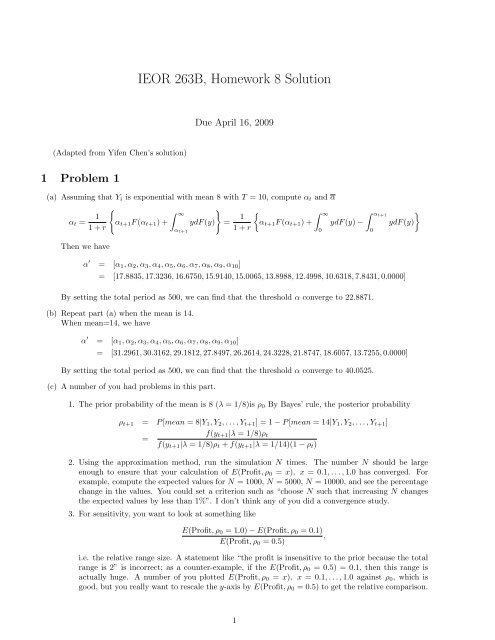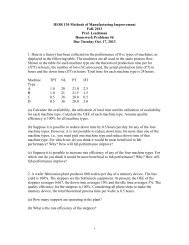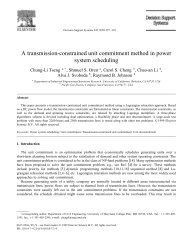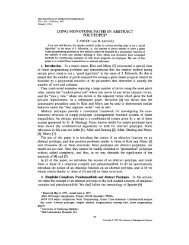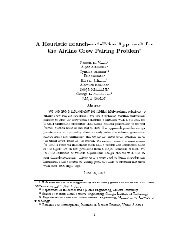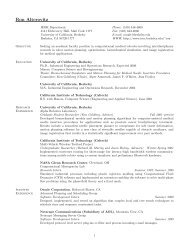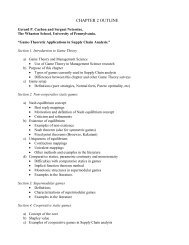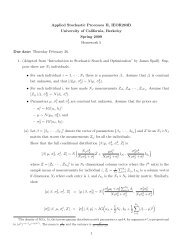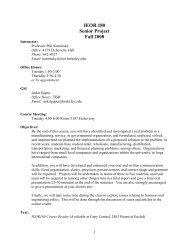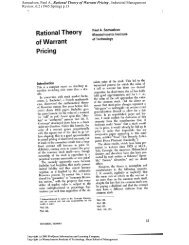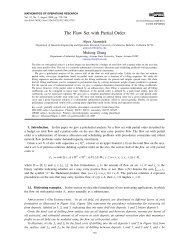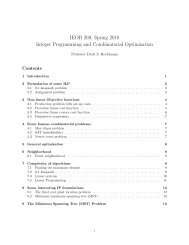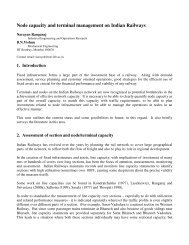IEOR 263B, Homework 8 Solution
IEOR 263B, Homework 8 Solution
IEOR 263B, Homework 8 Solution
Create successful ePaper yourself
Turn your PDF publications into a flip-book with our unique Google optimized e-Paper software.
(Adapted from Yifen Chen’s solution)<br />
1 Problem 1<br />
<strong>IEOR</strong> <strong>263B</strong>, <strong>Homework</strong> 8 <strong>Solution</strong><br />
Due April 16, 2009<br />
(a) Assuming that Yi is exponential with mean 8 with T = 10, compute αt and α<br />
αt = 1<br />
�<br />
� �<br />
∞<br />
αt+1F (αt+1) + ydF (y) =<br />
1 + r<br />
1<br />
�<br />
� ∞ � �<br />
αt+1<br />
αt+1F (αt+1) + ydF (y) − ydF (y)<br />
1 + r<br />
0<br />
0<br />
Then we have<br />
αt+1<br />
α ′ = [α1, α2, α3, α4, α5, α6, α7, α8, α9, α10]<br />
= [17.8835, 17.3236, 16.6750, 15.9140, 15.0065, 13.8988, 12.4998, 10.6318, 7.8431, 0.0000]<br />
By setting the total period as 500, we can find that the threshold α converge to 22.8871.<br />
(b) Repeat part (a) when the mean is 14.<br />
When mean=14, we have<br />
α ′ = [α1, α2, α3, α4, α5, α6, α7, α8, α9, α10]<br />
= [31.2961, 30.3162, 29.1812, 27.8497, 26.2614, 24.3228, 21.8747, 18.6057, 13.7255, 0.0000]<br />
By setting the total period as 500, we can find that the threshold α converge to 40.0525.<br />
(c) A number of you had problems in this part.<br />
1. The prior probability of the mean is 8 (λ = 1/8)is ρ0 By Bayes’ rule, the posterior probability<br />
ρt+1 = P [mean = 8|Y1, Y2, . . . , Yt+1] = 1 − P [mean = 14|Y1, Y2, . . . , Yt+1]<br />
=<br />
f(yt+1|λ = 1/8)ρt<br />
f(yt+1|λ = 1/8)ρt + f(yt+1|λ = 1/14)(1 − ρt)<br />
2. Using the approximation method, run the simulation N times. The number N should be large<br />
enough to ensure that your calculation of E(Profit, ρ0 = x), x = 0.1, . . . , 1.0 has converged. For<br />
example, compute the expected values for N = 1000, N = 5000, N = 10000, and see the percentage<br />
change in the values. You could set a criterion such as “choose N such that increasing N changes<br />
the expected values by less than 1%”. I don’t think any of you did a convergence study.<br />
3. For sensitivity, you want to look at something like<br />
E(Profit, ρ0 = 1.0) − E(Profit, ρ0 = 0.1)<br />
,<br />
E(Profit, ρ0 = 0.5)<br />
i.e. the relative range size. A statement like “the profit is insensitive to the prior because the total<br />
range is 2” is incorrect; as a counter-example, if the E(Profit, ρ0 = 0.5) = 0.1, then this range is<br />
actually huge. A number of you plotted E(Profit, ρ0 = x), x = 0.1, . . . , 1.0 against ρ0, which is<br />
good, but you really want to rescale the y-axis by E(Profit, ρ0 = 0.5) to get the relative comparison.<br />
1
2 Problem 2<br />
In each period, the amount of money the blackmailer already have is fixed and not relevant for decision<br />
making. Hence, in each period, the blackmailer only need consider the future return. In the last period, the<br />
value function of the blackmailer is<br />
�<br />
VN (uN ) = max R, max<br />
uN ∈[0,1] {uN(1<br />
�<br />
− uN)} = max<br />
�<br />
� �<br />
R, max − uN −<br />
uN ∈[0,1]<br />
1<br />
�2 2<br />
+ 1<br />
��<br />
4<br />
Hence, we can see that in period N, the blackmailer will offer a lump sum R to the victim if R > 1/4, otherwise,<br />
the blackmailer will demand a payment of u = 1/2 and the expected return is 1/4.<br />
In period t < N, if the blackmailer decide to demand a payment of ut, the probability that he can keep<br />
blackmailing is 1 − u and he can get u plus the future return, Vt+1(ut+1). So, the value function is<br />
�<br />
�<br />
Vt(u) = max R, max {(1 − u)[u + Vt+1(ut+1)]}<br />
(2)<br />
= max<br />
= max<br />
�<br />
u∈[0,1]<br />
�<br />
R, max<br />
u∈[0,1]<br />
� �<br />
R, max<br />
u∈[0,1]<br />
−<br />
−<br />
�<br />
u −<br />
�<br />
u −<br />
We can analyze this problem according to the value of R.<br />
First, observe that in period N − 1, if R ≥ 1/4, we have<br />
� ��<br />
2<br />
2<br />
(1 − Vt+1)<br />
(1 − Vt+1)<br />
+ Vt+1 +<br />
2<br />
4<br />
�2 (1 − Vt+1)<br />
+<br />
2<br />
(1 + Vt+1) 2<br />
��<br />
4<br />
VN−1(u) = max{R, max {(1 − u)(u + R)}}<br />
u∈[0,1]<br />
� � �<br />
� ��<br />
2<br />
(1 − R) (1 − R)2<br />
= max R, max − u − + R +<br />
u∈[0,1]<br />
2<br />
4<br />
= R +<br />
(1 − R)2<br />
4<br />
In this case, if R < 1, demanding a payment u is better than accepting a lump sum and the optimal uN−1<br />
will be (1 − R)/2. Also, we have VN−1 = (1+R)2<br />
< 1. Then in the previous period, from equation (2), u will be<br />
(1−VN−1)<br />
2<br />
(1+VN−1) 2<br />
4<br />
and VN−2 = 4 < 1. Hence, we know that even though the Value function is nondecreasing<br />
in −t, it is bounded above by one. This tell us that the blackmailer will always choose to demand a payment<br />
.<br />
ut = (1+VN−1)<br />
2<br />
However, if R ≥ 1, the optimal u is 0 because u ≥ 0 and the last term in the maximization is concave in u.<br />
The blackmailer gets the same return no matter what his decision is. However, we know that waiting for one<br />
period doesn’t give the blackmailer any benefit. Hence, we know if R > 1, the blackmailer will accept a lump<br />
sum R in the first period. If R < 1/4, we have<br />
� � �<br />
VN−1(u) = max R, max (1 − u) u +<br />
u∈[0,1]<br />
1<br />
���<br />
4<br />
� � �<br />
= max R, max − u −<br />
u∈[0,1]<br />
3<br />
�2 +<br />
8<br />
1<br />
��<br />
9<br />
+<br />
4 64<br />
= 1 9<br />
+<br />
4 64<br />
Again, demanding a payment u is better than accepting a lump sum. The optimal uN−1 will be 3/8. This is<br />
just the same as the case that R = 1/4.<br />
In conclusion, we have<br />
1. If R ≥ 1, the optimal policy is accept a lump sum R in the first period.<br />
2<br />
(1)<br />
(3)<br />
(4)
2. If 1 > R ≤ 1/4, the optimal policy is demanding a payment uk = (1+Vk+1)<br />
2 when k < N. And, in the last<br />
period, accept R instead of require a payment u.<br />
3. If R < 1/4, the optimal policy is always demanding a payment uk = (1+Vk+1)<br />
2 while the last u should be<br />
1/2 to maximize the whole profit.<br />
3


